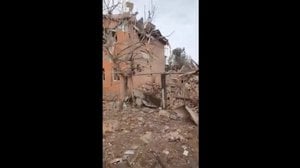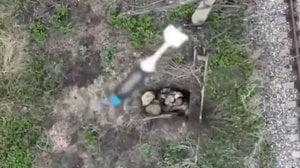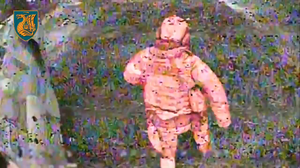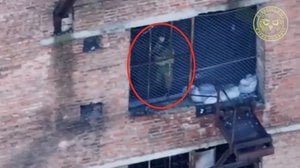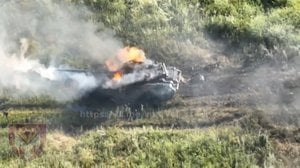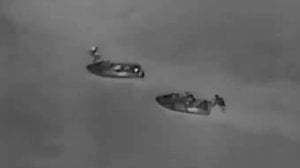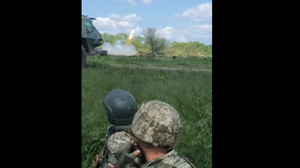
Armored Assault Near Bakhmut
Published 1 years ago
More footage of the 2nd Battalion, 3rd Assault Brigade in action near Bakhmut. Ukrainian tanks engage Russian forces in a tree line south of the city. The video opens with drone shots of Ukrainian tanks and at least one APC travelling along a trail at the base of a low ridge which provides them with defilade from the tree line. The tanks crest the ridge, traversing a low saddle, and once on the forward slope begin engaging Russian positions. Perspective switches back and forth between the tank and the drone shot, and we see thank crews employing their systems rather well. They use their mounted smoke grenade launchers and engage targets with both main gun and the commander’s PKT. The tanks refuse to remain still and maneuver to avoid return fire. At one point an FPV shot from the tank shows a muzzle flash of return fire in the trees. Movement can be seen in the trees, likely vehicles, but the type and number are unknown. Towards the end of the video one of the tanks activates its internal smoke generator, most likely to break contact. Towards the end of the video, artillery can be seen landing on and behind Russian positions, and from the tank’s perspective we see shells landing directly to their front.
The tank employment appears pretty solid. I do not know how closely these actions were integrated with infantry, or whether infantry assaulted another section of the line. Most of what we see are these two tanks and what they face to their immediate front. Despite the deficiencies of Soviet-era armor, this video is an indication that tactics can mitigate flaws in design. Not knowing the concept for this operation, I am hesitant to criticize artillery employment. I would have wanted IDF suppressing the target during movement of the objective, and so one wonders why arty did not fire until later in the engagement. Perhaps the tankers bit off more than they could chew and called for supporting fires. I will say that the artillery landed about where it needed to land – on the enemy position and astride their avenue of retreat. Assuming that this was indeed Ukrainian artillery, and not Russians dropping artillery on their own positions, the level of trust and confidence between the armor crews and the firing agencies is impressive.
It is worth noting that mines do not seem to be a factor in this engagement. Despite its apparent strategic irrelevance, Bakhmut has been coveted by both sides in this conflict. I have theorized that the city serves two significant functions in Ukraine’s current operational scheme. First, because Bakhmut was seized so recently by the Russians, they had had less time to prepare elaborate defenses as they have Zaporizhia, thus creating an opportunity for the Ukrainians to advance incrementally and to attrit Russian forces in the process. Second, Ukrainian efforts around Bakhmut have managed to fix in place many higher tier Russian units, preventing them from reinforcing other sectors of the front.
About the Author
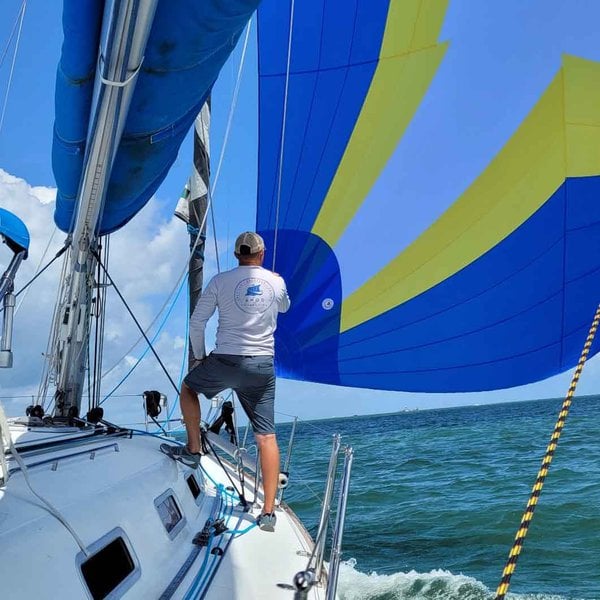
Cam
Cam served as an infantry officer in the Marine Corps, deploying to the Horn of Africa and participating in combat operations in Iraq. He currently works in the maritime industry and in the defense sector as an instructor of combined arms planning and operations. An avid sailor, Cam founded and directs a nonprofit that supports veterans and first responders through sailing.



